YouTube Ads are perfect for eCommerce.
YouTube Ads excel at driving exposure across the world’s second-largest search engine, capturing attention at the top, middle, and bottom of your eCommerce marketing funnel.
And this is especially true since the onset of iOS 14, and the impact that it’s had on the other DTC customer acquisition behemoth, Facebook. Not only is Facebook Ads data unreliable, but audience sizes are shrinking, and eCommerce marketing ROI is suffering as a result.
Enter YouTube.
Perhaps the key benefit of YouTube over Facebook, lies in its ability to leverage data from the Google Ads ecosystem. For example, you can target people on YouTube based on the search queries they use on Google. Not only is that an incredibly powerful targeting mechanism, it’s infinitely more reliable than Facebook’s interest-based targeting. In fact, there are approximately 25 ways you can target the average Youtube user, compared to 10 for Facebook.
Sign up to our free Google Ads email course.
7 days, 7 lessons. Everything from how to structure your Google Smart Shopping campaigns to ad testing, and YouTube ads excellence. Sign up and level up your Google Ads eCommerce game.
But First, A Quick YouTube Ads eCommerce Case Study
Following its initial launch in early-2018, luxury skincare brand Augustinus Bader has gone on to dominate beauty columns, racking up an impressive 40+ award wins, including being recently voted as The Greatest Skincare of All Time by Women’s Wear Daily.
Backed by over 30 years of research on skin healing and tissue repair by Professor Augustinus Bader, a pioneering force in stem cell biology, Augustinus Bader has successfully disrupted an industry which produces thousands of new creams every year.
In both clinical trials and consumer studies, the brand’s products have proven to address concerns such as the appearance of fine-lines and wrinkles, redness, hyperpigmentation, cellulite, and stretchmarks as well as visibly reducing the damage caused by external stressors.
Despite having a great product, reaching the right audience, across multiple geographic markets has not always been straightforward, and relying on search alone to drive digital discovery wasn’t enough to scale global growth.
And then came YouTube Ads.

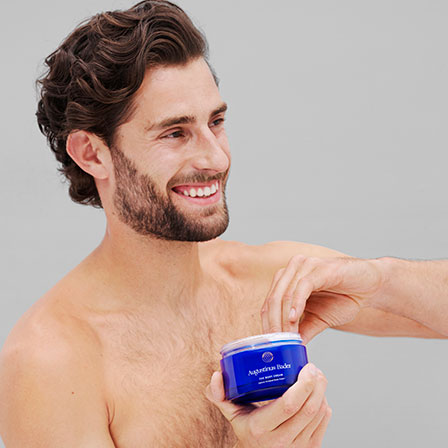


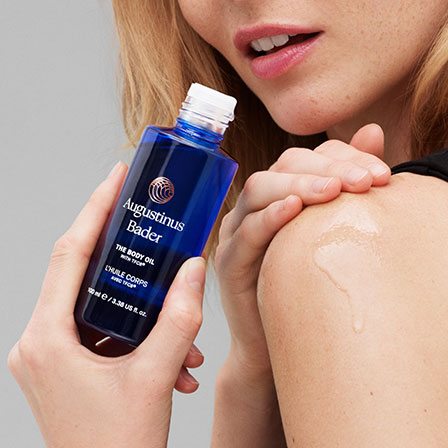
The Solution
Having run search and shopping campaigns for the brand with great success, the next step in driving exponential growth was obvious: YouTube ads.
To do so meant creating close to 60 YouTube campaigns in total, targeting specific countries and audiences based on relationship to the brand. Key to this was creative. How could we unlock the right creative for the right audience, based on how much they new about the brand, and previous purchase behaviour.
A focus on revenue was always going to be important in order to justify investing in YouTube as a platform, and blimpp was one of the first agencies involved with the YouTube cross-network beta, an advanced attribution report within Google Ads. This measurement tool provided greater insight into last-click and assisted revenue performance based on both click and view interactions, and was key to understanding which videos assets were driving meaningful actions – going beyond basic reporting on metrics such as views and watch rate.
Across each audience type, a number of videos were rotated so to find the winning combination of length and creative theme. Within this mix, both skippable and unskippable ad units were used, with a range of narratives adopted including social proof, before and after shots, celebrity endorsements, founder-led interviews and award wins.

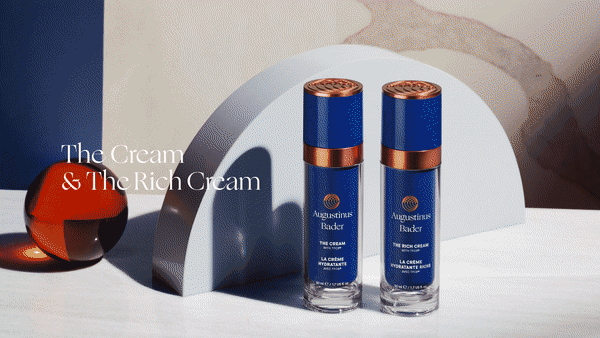
The Results
In just a matter of months, YouTube has become a leading digital touchpoint, driving both awareness and re-engagement. For a luxury skincare brand with little or no presence on TV, unlocking the power of video meant testing creative at a rapid pace, across multiple audience segments. The payoff?
- 101% Year-on-Year revenue uplift
- 98% increase in Year-on-Year transactions
- 186% increase in US brand traffic
- 340% increase in YouTube blended revenue
- An average View Rate of 13.4%, across both prospecting and retargeting workstreams
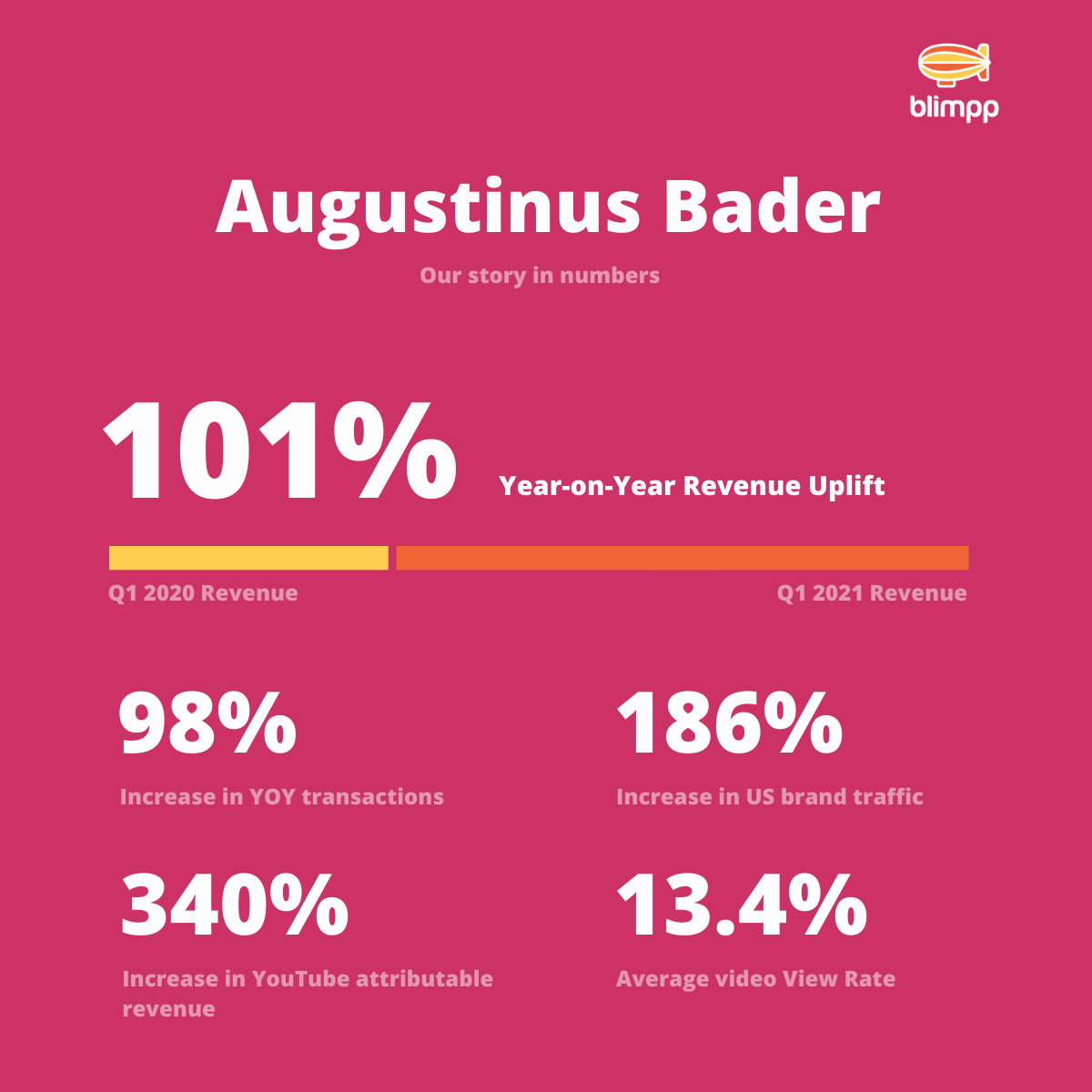
Why eCommerce brands need to invest in YouTube Ads
YouTube ads are video ads that are displayed on YouTube, shown to users either before, during, or after other YouTube videos – based on the user’s viewing habits and your campaign goals.
YouTube ads are part of the Google Ads ecosystem, which means that YouTube delivers strong targeting capability for brands to connect with their audience at different stages of the marketing funnel.
While Facebook targeting is predominantly interest-based, YouTube also allows audience targeting based on a user’s search history. In addition to targeting viewers, YouTube also allows you to target specific videos and even entire YouTube channels; this means you can always be sure that your eCommerce brand is reaching a relevant audience, no matter how niche.
Moreover, YouTube ads are one of most cost-effective forms of advertising. The average Cost Per View on YouTube can be as low as $0.02, whereas the average CPV on Facebook can be be up to $0.15.
YouTube ads can be used to build both brand awareness and drive sales, delivering stronger engagement than TV. According to the 2021 WYZOWL report, 87% of video marketers claim that video has increased traffic to their website, and 78% say that video has positively impacted their sales.
To sum up, YouTube ads can help you drive DTC eCommerce growth by:
- Reaching a wider audience
- Targeting customers with more relevant ads
- Get the most out of your advertising budget
- Increase sales and other important KPIs, such as revenue and AOV
How to choose the right YouTube Ad format
There are several YouTube ad formats to choose from, for eCommerce brands. Each format offers specific benefits, and each one has a role to play within your marketing funnel.
The best way to decide which YouTube ad format is best for you depends on your eCommerce marketing goals and your target audience.
Skippable in-stream video ads
The skippable in-stream video ads (previously called TrueView) appear pre-, mid-, or post-video when watching other YouTube videos. These ads are skippable, which means that the viewer has the option to skip them after watching the first five seconds.
When to use skippable in-stream video ads
The idea behind this video ad format is to give YouTube users more choice, while still providing advertisers with a way to reach their target audience. However, the skippable nature of these ads requires that video creators pique the user’s interest early, so they watch beyond the first five seconds.
When using this ad format, you pay only when the user watches more than 30 seconds or the full video – making it an appealing format for advertisers, especially when you are just getting started with YouTube ads. You can start with a small budget, then optimise and scale what’s working. You can optimise skippable in-stream ads to boost brand awareness, traffic, and sales.

Non-skippable in-stream video ads
Similar to the skippable ad format, non-skippable in-stream video ads may also appear before, during, or after viewing other videos. They are 15-20 seconds long and the key difference here fro skippable ads are that users must watch the full ad – with no option to skip – before continuing to watch their video.
When to use non-skippable in-stream video ads
These types of video ads demand a viewer’s attention and are charged on a CPM basis (cost per thousand impressions).
Because viewers have to watch the full ad length, these types of ads can be more expensive than other ad formats. That’s why non-skippable in-stream video ads work best for brands who are willing to invest budget in boosting their brand and product awareness. These can also be useful to retarget people that have visited your website recently or viewed other YouTube ads, in order to try and persuade them to take a desired action.
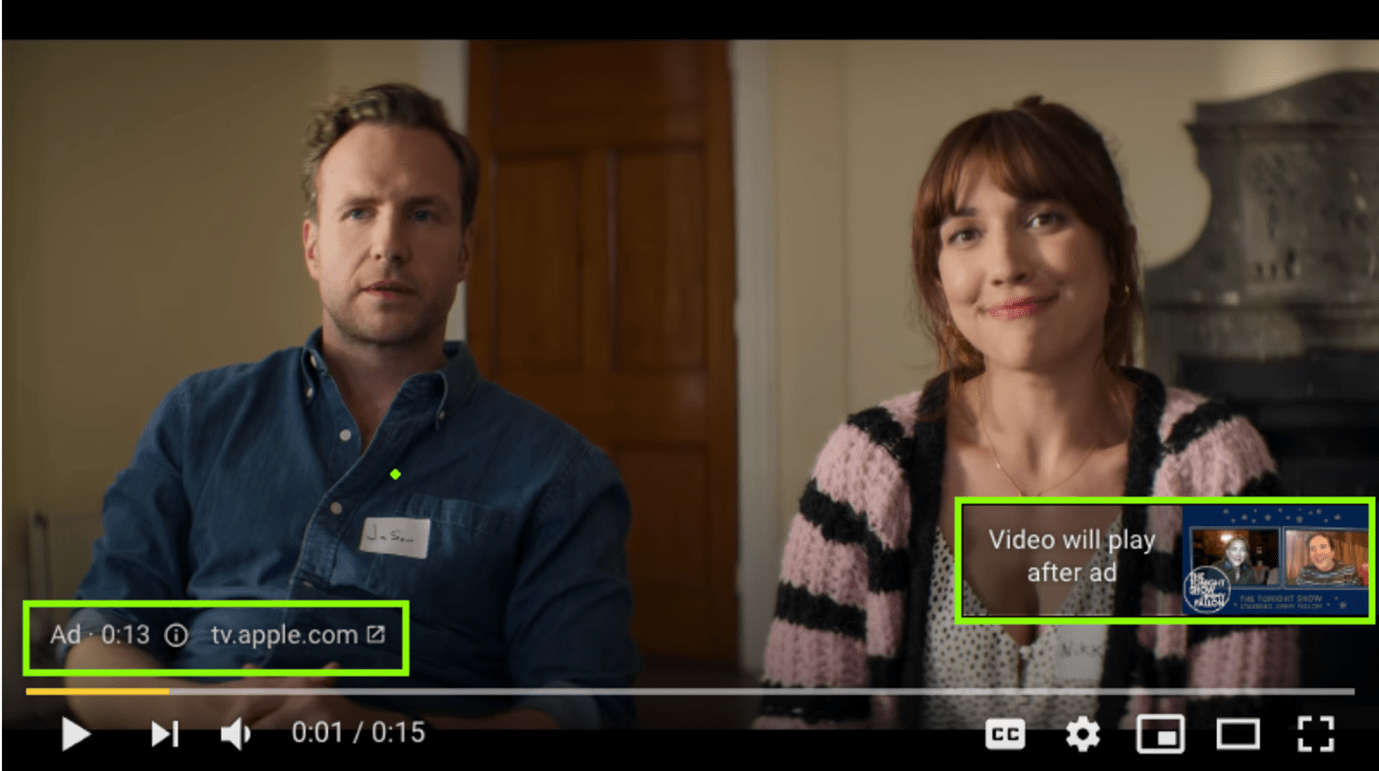
Bumper YouTube ads
Bumper ads are the shortest type of YouTube video ad format. They are at most six seconds long, non-skippable, and play before or during other YouTube videos.
When to use bumper YouTube ads
Given the short duration of bumper ads, they are often used to promote your products to a new audience or to reinforce a brand message.
While short, Google research shows that these types of ads were found to drive a 61% increase in brand awareness. Google also found that product shots were especially effective, as in the example below from Renault.
Sequenced YouTube ads
Video ad sequence campaigns are made up of a series of video ads, including skippable, non-skippable, and bumper ad formats. These type of ad campaigns are shown to users through a series of pre-defined steps, where each step has its own ad group and a particular video ad.
When to use sequenced YouTube ads
According to Ipsos’ research, sequenced ads allow brands to tell better brand and product stories. They’re also proven to be much more effective than other ad formats by positively impacting key ad metrics such as awareness, purchase intent, as well as greater message recall and retention.
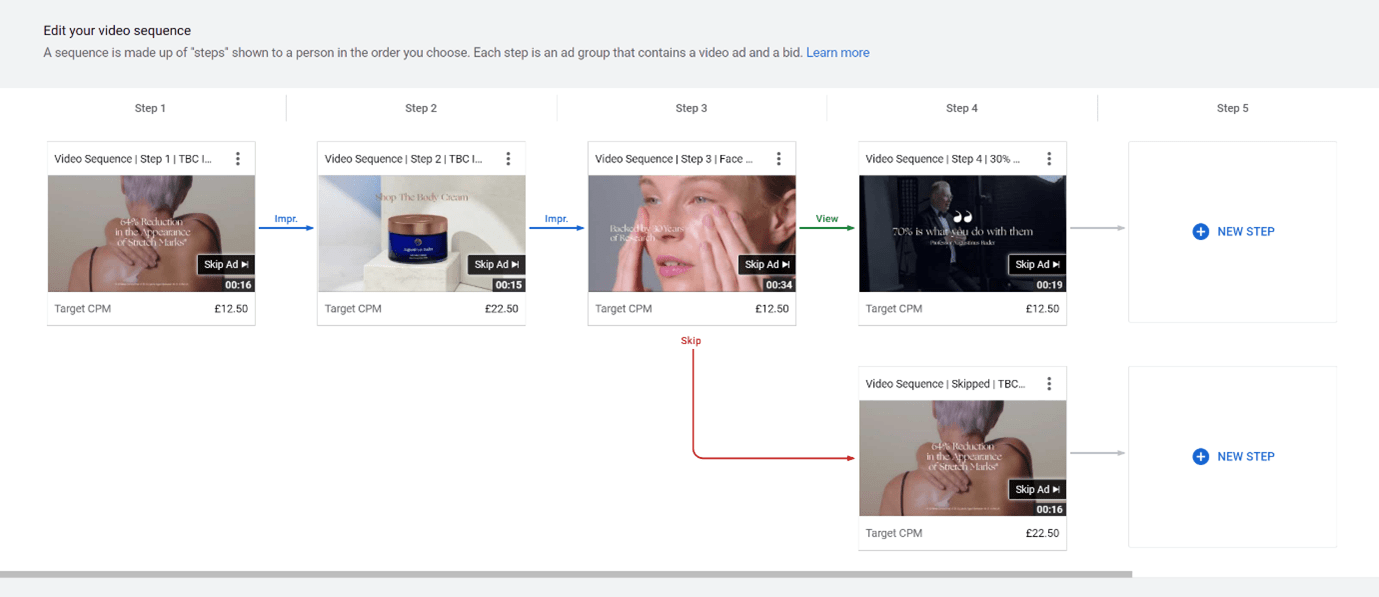
Key YouTube ad performance metrics
There are a few key performance metrics you’ll need to pay attention to determine the success of your YouTube ad campaigns, and then optimise as necessary.
YouTube offers advanced analytics beyond just clicks and views, giving you meaningful insight into campaign and ad efficiency. The insights you focus on will depend on your campaign objectives.
It’s also good to keep in mind that performance metrics may not mean much on their own. You should look at them in aggregation with other metrics and benchmarks.
The key performance metrics you should pay attention to include:
Impressions
The number of impressions shows how many times your ad was put in front of your target audience.
Why impressions are important
Impressions are important because they show how often your ads could have served. If you’re seeing a limited number of impressions, it could be because your ads fail to meet YouTube’s stringent ad standards, which would see your ads fail to run, or serve only to a small part of your target audience.
Views
A view is counted when someone watches at least 30 seconds of your ad (or the whole ad if it’s shorter than 30 seconds), or interacts with it.
Why views are important
The number of views is generally a great indicator of the quality of your video ad. If people watch for more than 30 seconds or the whole video it means that they found the content relevant – you managed to capture and hold their attention. This scenario can also be an indicator that your ad targeting is reaching the right people.
Conversely, a low number of views can also be an indicator of other underlying campaign issues, such as low budget. If you are targeting competitive keywords or audiences, then remember that your bid must be higher than that of your competitors for your ad to be served.
View Rate
This metric is calculated by dividing total views by total impressions, showing the percentage of viewers who watched your ad or interacted with it when it was shown to them.
Why the view rate is important
Similar to the above metric, View Rate is an engagement metric that helps you evaluate how well your creative is performing. The higher the View Rate, the more appealing your ad is to the target audience.
The View Rate can also help you determine whether your targeting is effective. If you’re targeting the right audience who finds the ad relevant, then they are less likely to press skip.
A low View Rate could mean that you’re not showing your ad to the right people and you need to work on understanding who your target audience is and how to properly reach them via YouTube ads.
A higher than average View Rate can also lead to a lower Cost Per View, which means you’ll pay less per view. To increase your View Rate you could make changes to the ad itself, or look into refining your ad targeting. In respect to creative optimisation, pay particular attention to the first five seconds of your ad, as this ultimately impacts highly on View Rate.
Video viewership
This metric gives insights into how many people watch 25%, 50%, 75%, or 100% of your video.
Why video viewership is important
The video viewership metric allows you to evaluate the ad creative with a critical eye. Pay attention to the video’s message and call-to-action within the 25%, 50%, and 75% thresholds. If most people don’t watch past the 25% mark, it could be that the video didn’t quite manage to capture the viewer’s attention early on. Or, if one video has 40% of users watching past the 75% mark while another video only has 10% of users reaching that mark, then you should ask the question: what made one audience watch and the other audience skip?
Cost Per View
CPV shows how much money you spend on average every time someone watches at least 30 seconds of your video, or the entire video if it’s shorter than 30 seconds.
Why CPV is important
This metric helps you make the most of your campaign budget – the lower the CPV, the less you pay for each view. On the other hand, if you have a high CPV, then you need to look at and optimise other aspects of your campaign in order to improve your performance. For example, a high CPV may be a result of targeting a narrow audience. Instead, you could try to expand your targeting or adjust your bid.
Moreover, the CPV is also linked to your View Rate. So, if you’re taking actions to optimise your view rate, such as improving engagement within the first five seconds, then your CPV should fall too.
Click-Through Rate
CTR is the percentage that shows the number of total ad clicks over the number of ad impressions.
Why CTR is important
Simply put, the CTR lets you know how effective your ad is in generating the desired action from the viewer. When watching your ad people can click to learn more or take advantage of an offer by clicking through to your website.
A low CTR suggests that your ad isn’t sufficiently piquing your audience’s interest, beyond the initial view. One reason could be down to targeting. Your ad should target people who are interested in what you have to say and sell. For example, if you’re a skincare brand that wants to reach people interested in anti-aging cream, it makes sense to exclusively target people over 35. Targeting 18–24-year-olds may result in low engagement, no matter the quality of your video.
Another factor that leads to a low CTR may also be the lack of a clear call-to-action (CTA). People need to be told what to do with the information they just received from you. For best results, end your video with a clear call-to-action, detailing where viewers can learn more about your product.

4 Tips for successful eCommerce YouTube ads - with examples
1. Have a clear marketing strategy in place
In order to have success with YouTube ads, you first need to have a well-thought marketing plan in place. This means that you should have a good understanding of who your target audience is and what your objectives are before you start spending money on your campaign.
When you map out a funnel, you can create YouTube campaigns that address users in different stages of their buying journey. You may also set up a sequence of ads to proactively move consumers through each step of the journey.
For example, if your objective is to introduce your brand to top-of-the-funnel audiences who are not familiar with your products, then your video should ignite interest in people by showing them what your products can do for them. If you’re targeting middle-of-the-funnel audiences, then you may want to focus on re-engaging website visitors with an offer-led creative that convinces them to take action.
BOOM! by Cindy Joseph has a clear idea of the marketing objectives they are trying to achieve with the above YouTube ad: specifically, middle-of-the-funnel customers who are already warm leads. Their ad speaks directly to their pain point of deciding between products within their comprehensive portfolio. Via this ad, the brand helps users make an informed decision and move them towards the final step of the buyer journey.
What they’re doing right:
- They have a clear understanding of their customer journey and objectives.
- The video immediately addresses the intended viewer’s pain point and promises a solution if they keep watching.
2. Make the first five seconds count
A YouTube ad is essentially interrupting a user’s desired outcome of watching their intended video – they’re most likely ready to press that skip button as soon as it becomes available. That’s why the first five seconds matter. You want to grab user’s attention and give them a reason to continue watching your ad, and ultimately engage with it.
Common themes here include framing a specific problem, employing a visual metaphor, or even using a celebrity to help hammer home your message.
Clothing brand Bonobos use the power of celebrity well, to drive that initial engagement. They start the ad by showing the NBA player Jimmy Butler saying the inspirational sentence “I refuse to let myself be limited” within the first five seconds of the video, which then leads into a powerful message of “wear what you want to wear, just don’t leave any doubts”.
What they’re doing right:
- A well-known figure attracts the attention of viewers and invokes curiosity.
- These type of video ads have an emotional pull. Getting users emotionally involved with the content early on will ensure that they continue to watch.
- Use music that reinforces the visual elements of the creative, particularly early on.
3. Show, don’t tell
This tip is especially relevant for DTC eCommerce brands. YouTube is a visual platform, allowing your potential customers to see your products and their benefits in action.
Moreover, many people may watch videos without sound, relying on captions. In fact, 64% of advertisers say that videos perform better when captions are included. In addition, this approach also makes your ads – and consequently, products – accessible to people who may have sound off, or who may have problems with hearing your video.
Gadget Insider utilises the “show, don’t tell” approach when promoting their Skye Drone. The ad highlights different product USPs, then immediately showcases them in action. Moreover, they also make use of overlay text to emphasise product features.
What they’re doing right:
- They immediately make it clear what the ad is about by showing the product in the first five seconds.
- The video uses both visuals and text to tell a story.
- The ad employs a dramatic soundtrack to reinforce the visual message, however is designed for “sound off” by focusing on visual cues and text overlays.
4. Include a clear CTA
So, you’ve achieved grabbing the viewer’s attention. Now they are interested in what you have to say or sell. What’s next? Having a clear CTA to guide the viewer through to the desired action.
Your YouTube ad CTA is linked to your campaign goals. Do you want to redirect users to a landing page where they can get more information or do you want to direct them to a sales-ready product page? The CTA will make things simpler for users and it will increase the chances of them taking the desired action.
When introducing the new Galaxy S21 Samsung in a pre-launch campaign ad, Samsung not only built excitement of the new launch, but also used a clear CTA – “Pre-order now” – to drive viewers to take the logical next step.
What they’re doing right:
- Using a strong action verb in the CTA.
- Adding “now” to the CTA increases urgency, enticing users to take immediate action.
Summary
Video advertising is a must-have part of your DTC growth marketing strategy. And when it comes to video ads, eCommerce brands cannot ignore YouTube – the largest video sharing platform that gives you access to over 2 billion monthly active users.
Besides sales, YouTube ads can also help your eCommerce business to increase its online brand awareness and reach, generate leads, and reinforce your brand messaging.
Before launching a YouTube ad campaign, you first need to have a clear marketing strategy in place and a good understanding of your target audience. Then, based on your business objectives, you can choose between different YouTube ad formats and which metrics to focus on.
Getting started with YouTube advertising can seem overwhelming. This guide aims to make it simple for you by arming you with a strong understanding of why YouTube ads are important for your eCommerce brand, how they function, and how you can measure and optimise your YouTube campaign performance.

